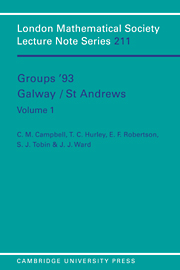Book contents
- Frontmatter
- Contents
- Preface
- Introduction
- Geometry, Steinberg representations and complexity
- The structure of metabelian finite groups
- Table algebras of extended Gagola-type and applications to finite group theory
- On the saturation of formations of finite groups
- Locally constructed formations of finite groups
- Reflections on virtually one-relator groups
- Rickard equivalences and block theory
- Computing the conjugacy classes of elements of a finite group
- Quotient categories of modules over group algebras
- Weak chain conditions for non-almost normal subgroups
- Computation of the character table of affine groups using Fischer matrices
- The lattice of compact representations of an infinite group
- Automorphisms of nilpotent and related groups
- Generation of orthogonal groups over finite fields
- The structure of certain Coxeter groups
- n-free groups and questions about universally free groups
- Classification of all generating pairs of two generator Fuchsian groups
- Parametric words and models of the elementary theory of non-abelian free groups
- The groups G(n, l) as fundamental groups of Seifert fibered homology spheres
- Lifting automorphisms: a survey
- (MI)-groups acting uniserially on a normal subgroup
- Revisiting a theorem of Higman
- Cohomological finiteness conditions
Geometry, Steinberg representations and complexity
Published online by Cambridge University Press: 02 March 2010
- Frontmatter
- Contents
- Preface
- Introduction
- Geometry, Steinberg representations and complexity
- The structure of metabelian finite groups
- Table algebras of extended Gagola-type and applications to finite group theory
- On the saturation of formations of finite groups
- Locally constructed formations of finite groups
- Reflections on virtually one-relator groups
- Rickard equivalences and block theory
- Computing the conjugacy classes of elements of a finite group
- Quotient categories of modules over group algebras
- Weak chain conditions for non-almost normal subgroups
- Computation of the character table of affine groups using Fischer matrices
- The lattice of compact representations of an infinite group
- Automorphisms of nilpotent and related groups
- Generation of orthogonal groups over finite fields
- The structure of certain Coxeter groups
- n-free groups and questions about universally free groups
- Classification of all generating pairs of two generator Fuchsian groups
- Parametric words and models of the elementary theory of non-abelian free groups
- The groups G(n, l) as fundamental groups of Seifert fibered homology spheres
- Lifting automorphisms: a survey
- (MI)-groups acting uniserially on a normal subgroup
- Revisiting a theorem of Higman
- Cohomological finiteness conditions
Summary
Group representation theory often relates quite different areas of mathematics and we shall give yet another example of this phenomenon. A construction from finite geometries will lead us to a new concept in representation theory which we shall then apply to the representation theory of Lie type groups. This, in turn, will involve ideas from the homological approach to modular representations. We shall, therefore, cover a spectrum of ideas.
One construction of finite projection planes involves the use of spreads. Suppose that V is a 2n-dimensional vector space over a finite field k of characteristic p. A spread S is a collection of n-dimensional subspaces whose (set-theoretic) union is all of V but where the intersection of any two members of the collection is zero. A group of linear transformations of V preserves the spread S if its elements permute the members of S.
Proposition 1.If E is an elementary abelian 2-group of linear transformations of V which preserve S and p = 2 then there is a subgroup F of E with the following two properties:
i) V is free as a kF-module;
ii) The space of fixed-points VF, of V under F, equals VE.
This is the key idea and we shall now formulate it in more generality. If E is an elementary abelian p-group and k is any field of characteristic p then the kE-module M is said to be subfree if there is a subgroup F of E with the two properties of the proposition.
- Type
- Chapter
- Information
- Groups '93 Galway/St Andrews , pp. 1 - 5Publisher: Cambridge University PressPrint publication year: 1995
- 1
- Cited by



